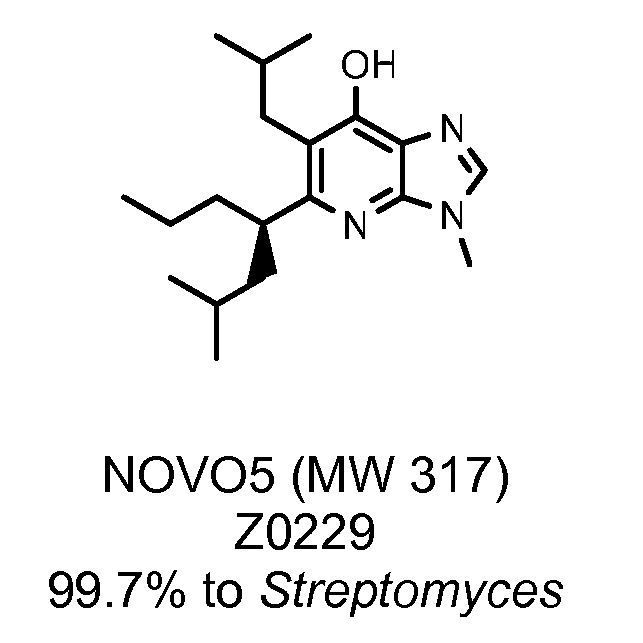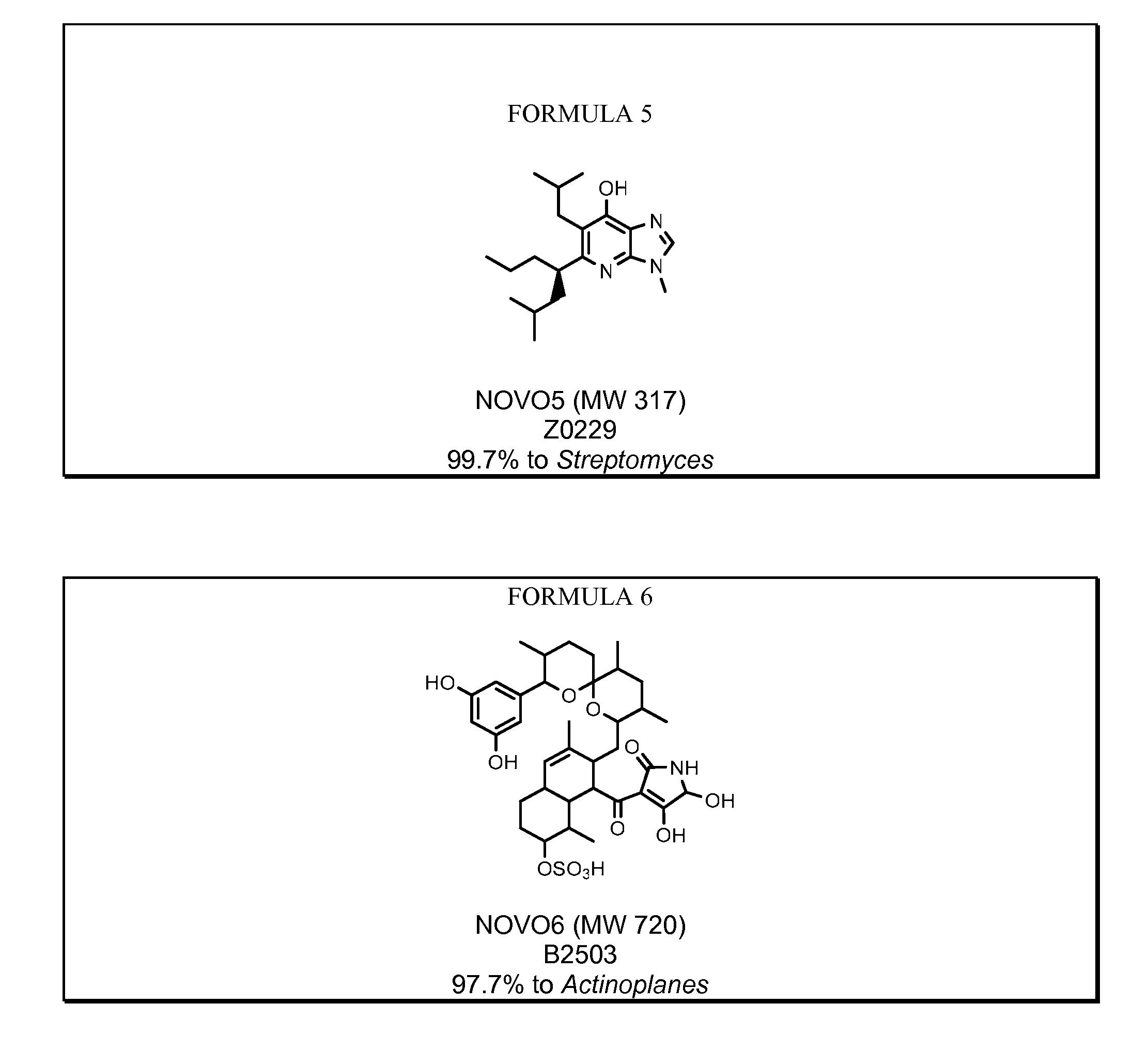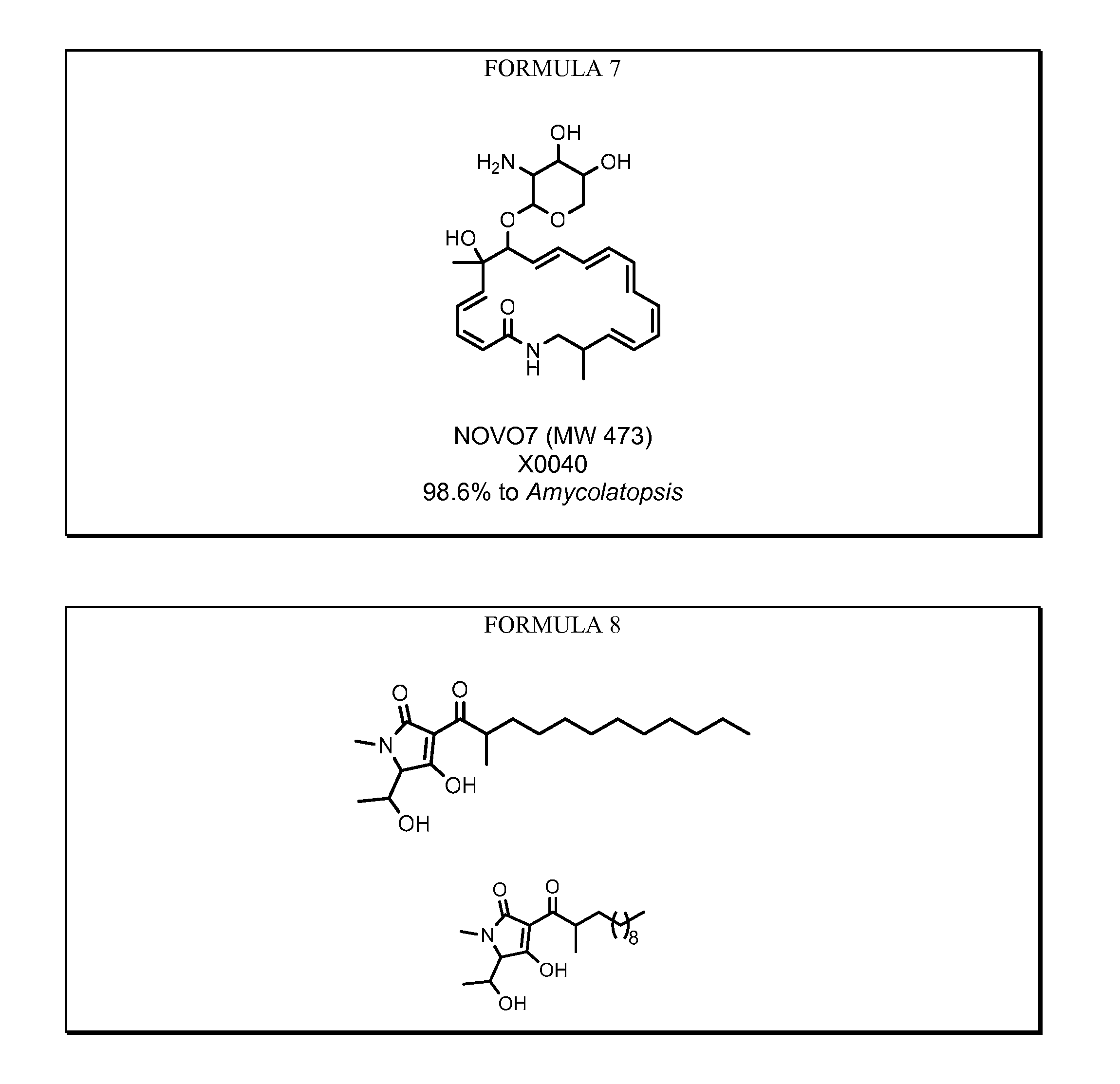Novel antibiotics
- Summary
- Abstract
- Description
- Claims
- Application Information
AI Technical Summary
Benefits of technology
Problems solved by technology
Method used
Image
Examples
example 1
Isolation of NOVO4
[0114]Bacterial isolate Z0363 was grown on 10% LB agar and one colony was homogenized and used to inoculate 40 ml of BP seed broth in a 250 mL flask. After 4 days of fermentation at 28° C. (250 rpm) the seed culture was used to inoculate 3.5 L of R4 production broth at 2.5% innoculum (v / v). The fermentation was conducted for 7 days at 28° C. (180 rpm) prior to harvest.
[0115]The fermentation broth (3.5 L) was centrifuged at 10,000 rpm for 20 minutes. The supernatant was extracted with n-butanol (3.5 L) and concentrated under reduced pressure, leaving an orange oil. Methanol and ethyl acetate (95:5, 40 mL) were added and a yellow precipitate formed. The suspension was allowed to rest at −20 C for 20 min and then centrifuged at 2,800 rpm at 4 C. The supernatant was removed and the precipitate was dried to a yellow powder (200 mg). This powder was dissolved in DMSO:H2O (80:20) and purified by RP-HPLC on a C-18 column (250×21.2 mm), eluting at 21.0 min. (H2O / AcN with 0....
example 2
Structural Formulation of NOVO4
[0116]The structure of NOVO4 was determined using NMR experiments, including 1H, 13C, COSY, DEPT-135, HSQC and HMBC NMR experimentation.
[0117]All NMR spectra were taken on a Bruker-DRX-500 spectrometer equipped with a 5 mm QNP probe. High resolution ESI-LC-MS data were recorded on a MicroMass Q-Tof-2 spectrometer equipped with an Agilent 1100 solvent delivery system and a DAD using a Phenomenex Gemini-C 18 reversed phase column (50×2.0 mm, 3 μm particle size). Elution was performed with a linear gradient using deionized water with 0.1% formic acid and acetonitrile with 0.1% formic acid as solvents A and B, respectively, at a flow rate of 0.2 ml / min. The gradient increased from 10% to 100% of solvent B over 20 minutes followed by an isocratic elution at 100% of solvent B for 8 minutes.
[0118]The formula of NOVO4 was determined to be C30H40N2O6 based on the [MH]+ adduct (calc. [C30H41N2O6]+=525.2965, obs. [C30H41N2O6]+=525.2963). See FIGS. 1 and 3 for 1H ...
example 3
NOVO4 has Antibacterial Activity
[0119]Antibacterial activity was demonstrated by measuring the ability of different concentration of NOVO4 to inhibit the growth of bacterial cells. This can be achieved in different assay format; bacteria growing on solid agar media or bacteria growing in broth such as for Example 5 and 6 (Minimal Inhibition Concentration).
[0120]For solid agar format, bacterial cells are first grown in a suitable media such as Mueller Hinton broth (MHB) until exponential phase (OD600600=0.02 in MHB, and evenly applied as a thin layer on the surface of a plate of solid growth media, such as MHB agar (about 0.1 ml onto a surface area of 100 cm2). After the surface is dried, a 5 μl aliquot of a 2-fold serial dilution of NOVO4 (in 50% DMSO) is spotted onto the surface of the agar plate. After 16 hr to 24 hr of incubation, depending on the bacterial strain of interest, the diameter of zones of growth inhibition is measured. For the purpose of demonstrating antibacterial a...
PUM
| Property | Measurement | Unit |
|---|---|---|
| Density | aaaaa | aaaaa |
| Density | aaaaa | aaaaa |
| Density | aaaaa | aaaaa |
Abstract
Description
Claims
Application Information
 Login to View More
Login to View More - R&D
- Intellectual Property
- Life Sciences
- Materials
- Tech Scout
- Unparalleled Data Quality
- Higher Quality Content
- 60% Fewer Hallucinations
Browse by: Latest US Patents, China's latest patents, Technical Efficacy Thesaurus, Application Domain, Technology Topic, Popular Technical Reports.
© 2025 PatSnap. All rights reserved.Legal|Privacy policy|Modern Slavery Act Transparency Statement|Sitemap|About US| Contact US: help@patsnap.com



